What is Chicken Broth?
Chicken broth is a flavorful liquid made by simmering bone-in, skin-on chicken pieces with aromatics, herbs, and spices. This versatile cooking essential serves as the foundation for countless dishes, from soups and stews to sauces and grain dishes. The process transforms simple ingredients into a nourishing, collagen-rich liquid that adds depth and complexity to your cooking.
What Does Chicken Broth Taste Like?
A well-made chicken broth offers a rich, savory flavor with subtle notes from the aromatics and herbs used during preparation. The classic mirepoix trio of onions, carrots, and celery provides a balanced foundation, while garlic and herbs contribute aromatic complexity. When properly made, the broth should have a light golden color and a clean, pure chicken flavor that’s neither too salty nor too bland. The texture should be slightly viscous due to the gelatin extracted from the bones and connective tissue.
The Other Chicken Broth Variation – Bone Broth
While traditional chicken broth typically simmers for 1.5-7 hours, bone broth represents a more intensive variation. This extended-simmering cousin cooks anywhere from 12-24 hours to maximize collagen extraction and mineral content. Many Taiwanese enthusiasts consider a cup of this deeply simmered broth equivalent to ten sheet masks for skin benefits due to its high collagen content.
Bone broth focuses specifically on drawing nutrients from the bones themselves, often incorporating more joints, feet, and cartilage-rich pieces. The extended cooking time breaks down these components completely, resulting in a thicker, more gelatinous liquid with intensified nutritional properties including higher protein content and more dissolved minerals.
Don’t Want to Make Chicken Broth?
If the 4-24 hour simmering time seems daunting, there are shortcuts. Store-bought options can serve in a pinch, though they rarely match homemade quality. Look for low-sodium versions from reputable brands, preferably those packaged in glass rather than cans. For a middle-ground approach, try enhancing store-bought broth with fresh aromatics and a 30-minute simmer. Alternatively, consider making a large batch of homemade broth when time allows, then freezing in portion-sized containers for convenience.
The Secret to Rich, Golden Chicken Broth: The One Thing You Must Know
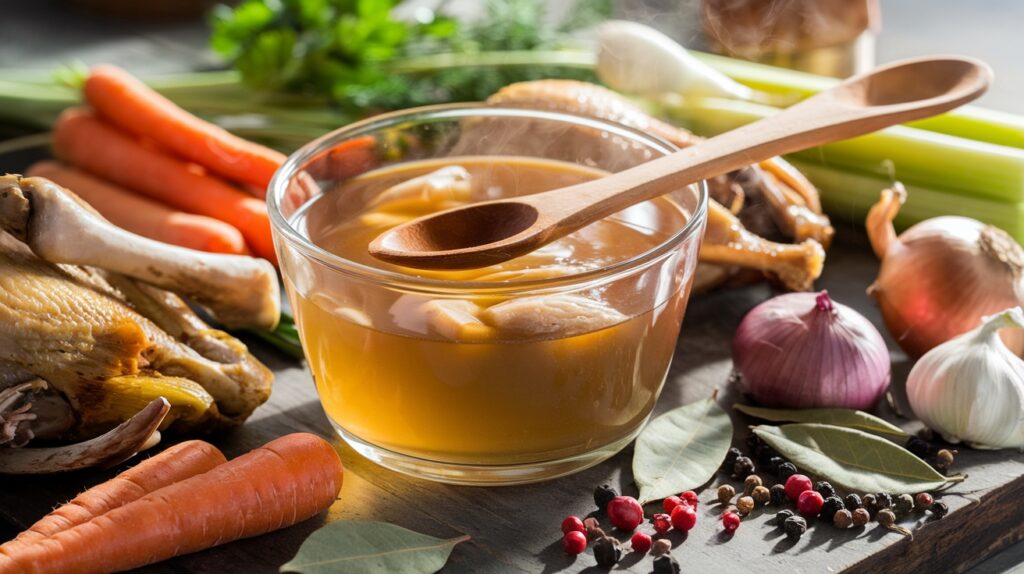

The magic of exceptional chicken broth happens during the extended simmer—anywhere from 4 to 24 hours. Maintaining the proper temperature is crucial: aim for a gentle bubble around the pot’s edge while avoiding vigorous boiling that clouds your broth. This patient approach allows collagen to slowly release from the bones and connective tissue, transforming your liquid into something truly special.
Around the 2-hour mark, crush the bones to release precious collagen that gives the broth its signature body and mouthfeel. For that golden hue that signals a professional-quality broth, add turmeric (¼-1½ tsp) and a splash of apple cider vinegar which helps dissolve minerals from the bones. Consider incorporating steam-cooked pumpkin for natural thickness and sweetness.
The skimming technique makes all the difference between murky, cloudy broth and crystal-clear golden liquid. Using a fine-mesh sieve, remove the whitish-gray foam that appears on the surface when your broth reaches a gentle simmer, before it boils. Using quick circular motions, skim this protein scum without disturbing the deeper liquid, rinsing your sieve between passes. This careful attention to detail, particularly in the first 10-15 minutes of cooking, ensures clarity worthy of fine dining.
Remember, don’t salt during cooking—only when serving. The result? A versatile, nourishing elixir that’s worth every minute invested.
Don’t Fear the Bones, Broil Them!
One common mistake that prevents home cooks from achieving restaurant-quality broth is skipping the pre-treatment of bones. Don’t let chicken bones intimidate you—transform them through roasting or pre-boiling to maximize flavor.
Pre-boiling bones for 20 minutes helps purge impurities that would otherwise cloud your broth. After this initial boil, drain and rinse the bones before starting fresh with cold filtered water. This two-step approach ensures clarity from the beginning.
For deeper flavor development, consider broiling the bones before simmering. This caramelization process creates rich Maillard compounds that add remarkable depth to your finished broth. Simply arrange bones on a baking sheet and broil until golden brown, being careful not to burn them, which would introduce bitterness.
When crushing bones midway through simmering, use a potato masher or the back of a large spoon to gently break them down, releasing the marrow and collagen trapped inside. This technique, often overlooked by novice broth makers, significantly enhances both the nutritional value and the rich mouthfeel of your finished broth.
Chicken Broth – Common Questions
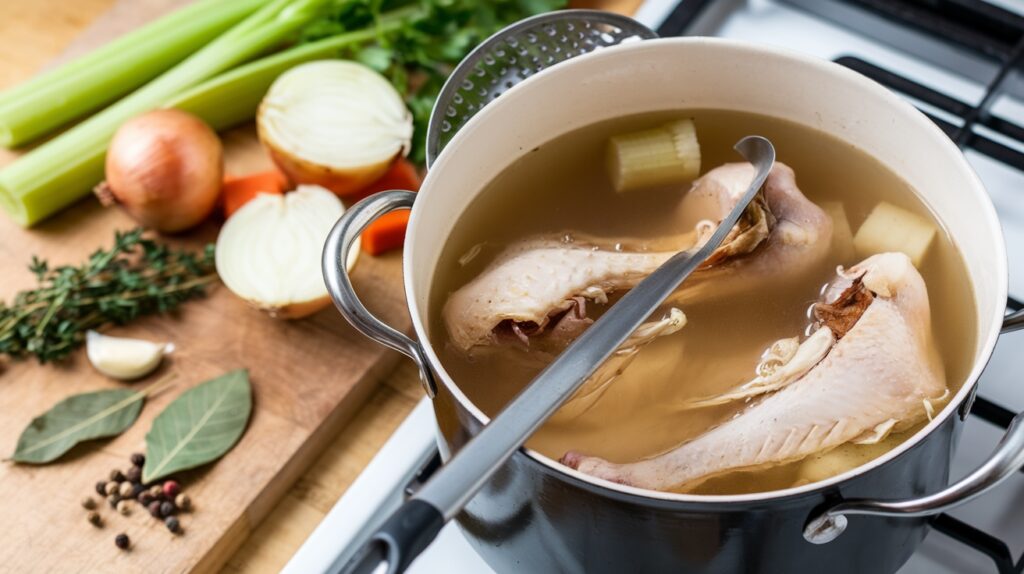

What’s Chicken Broth Made of?
Quality ingredients form the foundation of exceptional chicken broth. The essential components include:
- Chicken: Bone-in, skin-on pieces—preferably thighs or a whole bird—to extract maximum flavor and collagen. Include giblets (except liver) for added depth.
- Aromatics: The classic mirepoix trio of onions, peeled carrots, and celery creates the flavor base. Whole garlic cloves (smashed) add complexity.
- Herbs: Fresh herb stems—parsley, thyme, and bay leaves work beautifully when bundled in a sachet for easy removal.
- Seasonings: Black peppercorns provide subtle heat. Kosher salt should only be added when serving, not during cooking.
- Liquid: Always begin with cold filtered water to promote clarity and proper extraction of flavors.
Remember that fresh, high-quality components create a cleaner, more vibrant broth than scraps or processed alternatives.
Is Chicken Broth Healthy?
Three remarkable health benefits make bone-based chicken broth a nutritional powerhouse:
First, it’s loaded with collagen-derived amino acids that boost skin elasticity, reduce wrinkles, and improve bone density—especially important for maintaining independence as you age. The anti-aging benefits are enhanced by lengthy cooking time that extracts maximum nutrients from the bones.
Second, it supports gut health naturally. The gelatin binds to water, promoting healthy digestion, while amino acids repair your gut lining and reduce inflammation associated with conditions like leaky gut and colitis. Regular consumption is particularly recommended for healing chronic conditions such as eczema, allergies, and food intolerances.
Third, chicken broth strengthens your immune system through key amino acids like glutamine and glycine that bolster gut-associated immunity. Studies show it can even reduce the severity of upper respiratory infections, keeping you healthy and free from unnecessary medications.
Is Chicken Broth the Same as Stock?
While often used interchangeably, chicken broth and stock have distinct differences. Traditional stock uses primarily bones with minimal meat attached, simmering for 3-4 hours to extract gelatin and minerals, resulting in a neutral flavor base. Stock typically remains unseasoned until used in specific recipes.
Broth, by contrast, incorporates more meat along with the bones, creating a more flavorful liquid that can be enjoyed on its own. It generally simmers for a shorter period (1.5-2 hours) and may include seasoning during cooking.
The line blurs further with bone broth, which follows stock’s bone-centric approach but extends simmering time significantly (12-24 hours) to maximize nutritional extraction. For practical home cooking, the techniques shared here create a hybrid that captures the best qualities of all three: the flavor of broth, the body of stock, and the nutritional benefits of bone broth.
Can You Use Chicken Broth in Recipes?
Homemade chicken broth elevates countless recipes beyond simple soups. Transform ordinary dishes into extraordinary meals—from classic chicken noodle to hearty stews and quick taco soups with beans and corn. Your homemade broth creates richer sauces for chicken pot pie and herb-infused pan sauces for cutlets.
Elevate grain dishes by swapping water with broth. Risotto, jambalaya, and wild rice bowls absorb those deep flavors you worked so hard to develop. Try paella with saffron-infused broth for an authentic touch. Even creamy dishes benefit—thin out broccoli cheese soup while maintaining silkiness, or deglaze pans for moisture-rich casseroles.
For creative variations, infuse your broth with ginger and cilantro for a zesty Asian-inspired soup, or add aromatic spices like cinnamon to create a Vietnamese-style pho base. Don’t forget classic comfort foods: your homemade broth elevates chicken pot pie filling and creates silky bases for chilis and stews. For an impressive side, try “melting potatoes,” where broth creates a caramelized exterior while keeping the interior tender and flavorful.
Every drop of your homemade broth adds depth that store-bought simply can’t match.
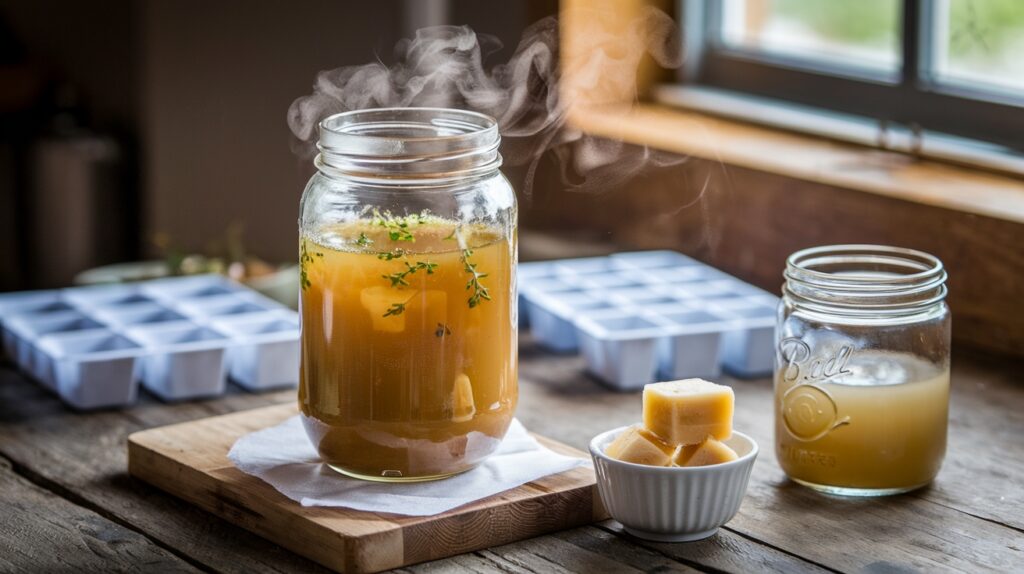

Chicken Broth Recipe
Transform simple chicken bones into liquid gold with this rich, golden chicken broth. Perfect for soups, sauces, and countless dishes, this recipe creates a nourishing elixir worth every minute invested. The longer simmering time produces a richer, more flavorful broth with incredible health benefits.
- Prep Time: 20 minutes
- Cook Time: 4-24 hours (depending on desired richness)
- Total Time: 4 hours 20 minutes – 24 hours 20 minutes
- Yield: 2–3 quarts of broth 1x
- Category: Basics, Broths, Soups
- Cuisine: International
Ingredients
Main Ingredients
- Bone-in, skin-on chicken pieces (preferably thighs or a whole bird)
- Chicken giblets (except liver)
- Cold filtered water (enough to cover chicken by 1-2 inches)
- 1 tablespoon apple cider vinegar
Aromatics
- 2 medium onions, quartered
- 3 carrots, peeled and roughly chopped
- 3 celery stalks with leaves, roughly chopped
- 4–6 garlic cloves, smashed
Herbs and Spices
- 1 bouquet garni (parsley stems, thyme sprigs, bay leaves)
- 1 teaspoon black peppercorns
- 1/4–1 1/2 teaspoons turmeric (optional, for golden color)
- Kosher salt (for serving only)
Instructions
- Pre-boil bones for 20 minutes to remove impurities. Drain and rinse the bones.
- Place chicken pieces breast-side down in a large stockpot with all aromatics.
- Add cold filtered water to cover ingredients by 1-2 inches.
- Add apple cider vinegar and let sit for 30 minutes (helps extract minerals).
- Bring to a boil over medium-high heat.
- Skim foam regularly for the first 15 minutes using a fine-mesh sieve.
- Reduce heat to maintain a gentle simmer – look for barely perceptible bubbles around the pot’s edge.
- Add herbs and spices in a bouquet garni or sachet for easy removal later.
- Simmer gently for 4-24 hours, depending on desired richness. If using a whole chicken, remove breast meat after 1 hour to prevent overcooking.
- Around the 2-hour mark, crush the bones to release collagen.
- Avoid excessive stirring throughout the cooking process.
- Strain broth through a fine-mesh sieve lined with cheesecloth.
- Cool rapidly to room temperature before refrigerating.
- Skim fat from the surface once cooled.
- Store properly in airtight containers.
Notes
- Storage: Refrigerate for 3-5 days or freeze for up to 3-6 months
- Golden color: Add turmeric for that signature golden hue
- Clarity tip: Always start with cold water and maintain a gentle simmer
- Flavor enhancer: Consider adding steam-cooked pumpkin for natural thickness and sweetness
- Optimal flavor: Season with salt only when serving, not during cooking
- Successful gel: A properly made broth will gel when cooled, indicating extracted collagen
- Alternative aromatics: Try leeks or bell peppers for subtle sweetness
- Freezing portions: Use ice cube trays for small recipe additions


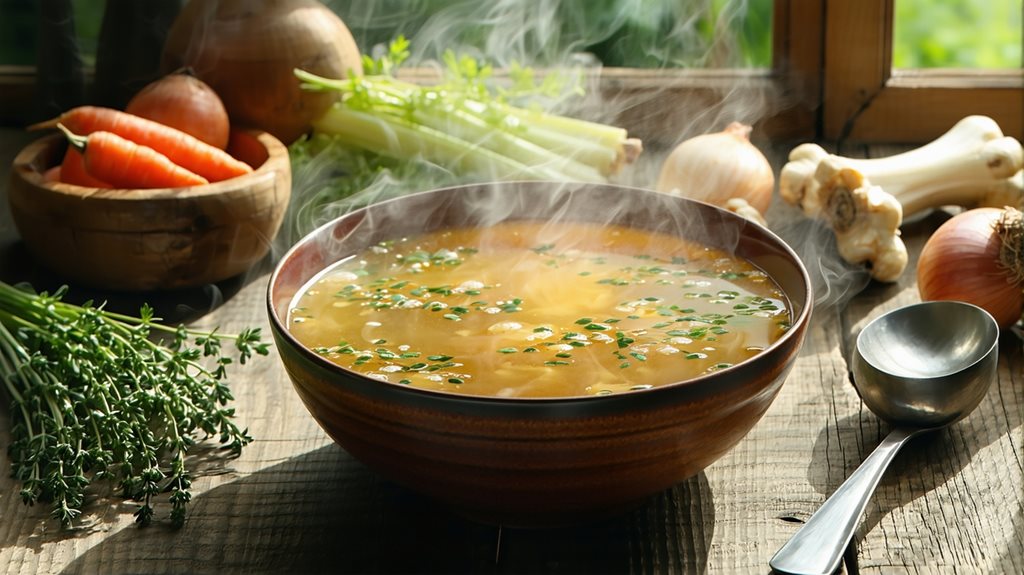



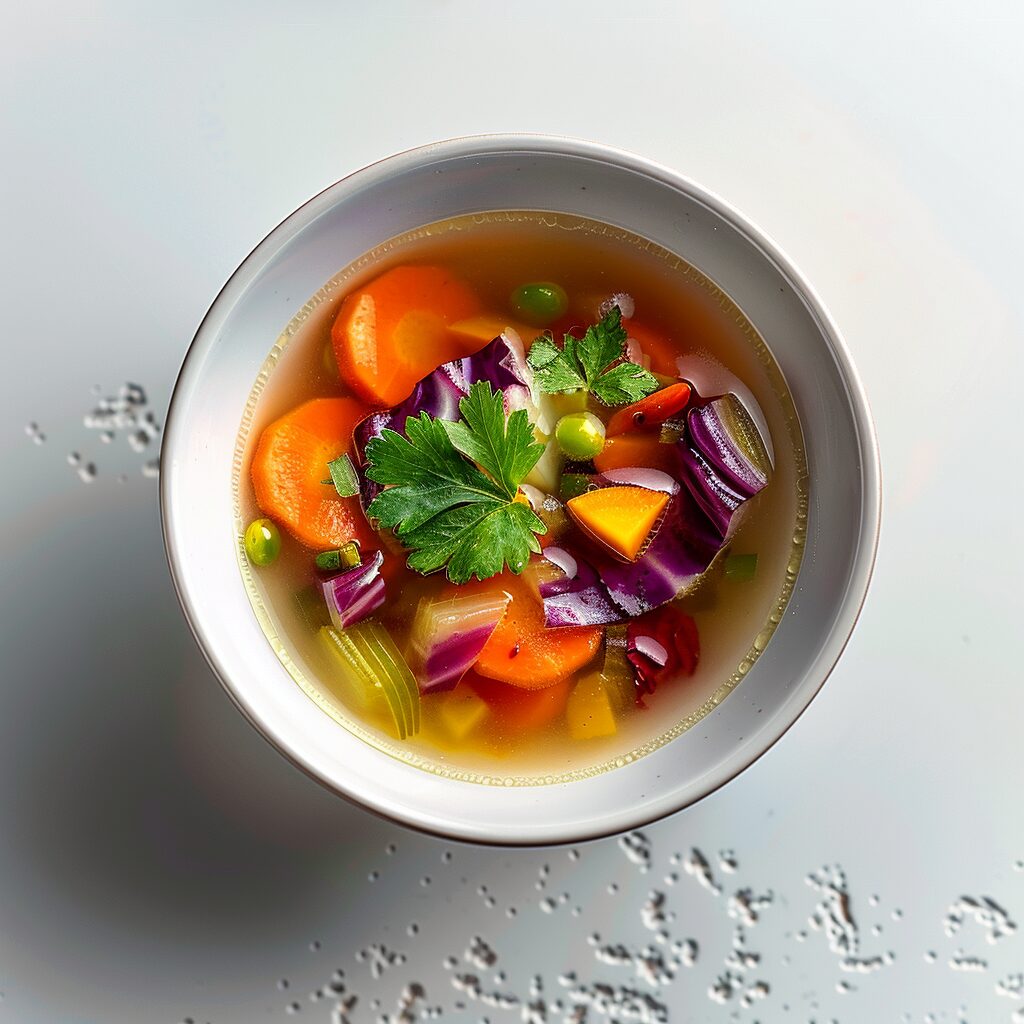

Konnichiwa! (Hello!) I'm Pat Tokuyama, a Japanese tofu cookbook author, who travels for music, food, and adventure. If you like Japanese tea, checkout some of the newestorganic japanese tea, matcha bowls and noren and more!
** Curious about the Plant Based Japanese Cooking Club? ** Learn more here!